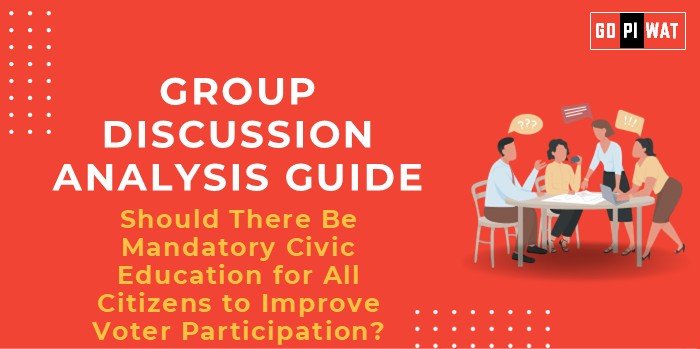📋 Group Discussion (GD) Analysis Guide: Should There Be Mandatory Civic Education for All Citizens to Improve Voter Participation?
🌟 Introduction to the Topic
Voter participation is a cornerstone of democracy. Yet, declining voter turnout in many nations raises concerns about democratic engagement and governance.
Civic education aims to inform citizens about their rights and responsibilities, including the importance of voting. Countries like Sweden and Australia incorporate civic education into their curriculum, contributing to higher voter turnout.
📊 Quick Facts and Key Statistics
- 🌍 Global Voter Turnout: 66.7% average turnout in the past decade; some countries, like Belgium, surpass 85%.
- 🇮🇳 India’s Voter Turnout (2019): 67.4%, with youth participation lagging behind older age groups.
- 📚 Civic Education Implementation: 50+ nations have mandatory civic curricula.
- 👩🎓 Youth Awareness: A 2023 survey in India revealed that only 40% of youth understand the electoral process.
- 🇦🇺 Global Best Practices: Australia’s compulsory voting and civic education lead to consistent turnout above 90%.
👥 Stakeholders and Their Roles
- 📜 Government: Policy implementation, funding, and curriculum development.
- 🏫 Educational Institutions: Deliver civic education programs and ensure engagement.
- 📢 Non-Governmental Organizations (NGOs): Conduct community awareness campaigns.
- 👩👩👦👦 Citizens: Active participation in voting and civic activities.
- 📰 Media: Disseminating information about civic rights and responsibilities.
✅ Achievements and Challenges
🏆 Achievements:
- 📈 Increased voter turnout: Countries with mandatory civic education, e.g., Sweden (82% turnout).
- 💬 Enhanced citizen engagement: Encourages active participation in policy debates.
- 🔍 Reduced misinformation: Civic education combats election-related misinformation.
⚠️ Challenges:
- 🛑 Resistance to mandatory policies: Especially in diverse societies with cultural differences.
- 💰 Financial and logistical constraints: Curriculum development and delivery in rural areas.
- 🌐 Disparities in access: Rural and marginalized communities often lack equal opportunities.
🌍 Global Comparisons
- 🇦🇺 Australia: High voter turnout due to compulsory civic education and voting.
- 🇺🇸 United States: Civic education is uneven, leading to turnout disparities.
- 🇮🇳 Case Study: Kerala, India, achieves high literacy and voter participation through integrated civic awareness programs.
📌 Structured Arguments for Discussion
- 🔹 Supporting Stance: “Mandatory civic education ensures an informed electorate, leading to better governance outcomes.”
- 🔹 Opposing Stance: “Forcing education infringes on personal freedoms and may not address systemic apathy.”
- 🔹 Balanced Perspective: “While civic education can enhance participation, its success depends on equitable implementation and public buy-in.”
🔍 Effective Discussion Approaches
- 📈 Opening Approaches:
- “Youth turnout in India remains a challenge despite being the world’s largest democracy—could civic education bridge the gap?”
- “Countries with mandatory civic education report higher turnout, showing its potential to strengthen democracies.”
- 🔄 Counter-Argument Handling:
- “While concerns about costs are valid, international examples like Estonia show low-cost digital education can be effective.”
- “Compulsion might seem intrusive, but it parallels the importance of mandatory public health programs.”
📈 Strategic Analysis of Strengths and Weaknesses
- ✅ Strengths: Informed electorate, higher turnout, reduced political misinformation.
- ⚠️ Weaknesses: Implementation challenges, potential cultural resistance.
- 🌟 Opportunities: Digital platforms for scalable civic education.
- ⚡ Threats: Polarization and misinformation undermining efforts.
🎓 Connecting with B-School Applications
- 💡 Real-World Applications: Projects on policy implementation, voter behavior analysis, and education technology solutions.
- 💬 Sample Interview Questions:
- “How can civic education impact voter behavior in developing nations?”
- “What role can technology play in making civic education accessible?”
- 📘 Insights for B-School Students: Focus on interdisciplinary approaches combining policy, technology, and social impact.


